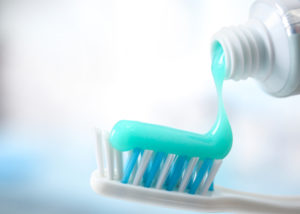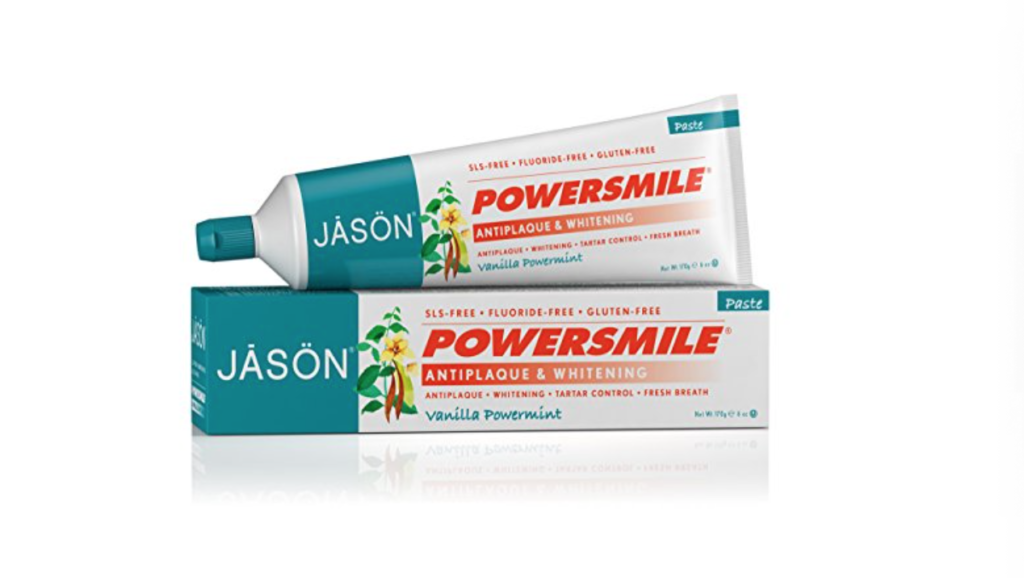
If you’ve ever taken a sublingual supplement (one that is held under your tongue), you’re most likely aware of the fact that what you put in your mouth is easily absorbed.
Because of this, it makes sense to pay attention to anything coming into contact with your mouth, including your toothpaste, mouthwash, and other dental care products, as they can be absorbed directly into your bloodstream, or even accidentally swallowed and digested.
And while toothpastes and “freshening” mouthwashes may look innocent enough, the unfortunate reality is that most are filled with chemicals and toxic substances that shouldn’t even be touching your skin, much less being absorbed in your mouth.
Luckily, there’s an alternative to using these toxin-filled products—and no, it doesn’t involve forgoing brushing altogether. But first, let’s take a look at why you’ll want to consider switching to natural dental care methods.
4 Dangerous Ingredients In Dental Care Products
Commercial dental care products contain a slew of chemicals that can have nasty side effects ranging from skin irritation to cancer.
1. Triclosan
Triclosan is a potent antibacterial and antifungal chemical found in many household products like antibacterial soaps and cosmetics. Unfortunately, it’s also found in toothpaste. And while it sounds harmless on its surface, triclosan’s side effects are nothing to shrug at.
Aside from being a huge contributor to deadly antibiotic resistance, triclosan acts as an endocrine disruptor, causing problems with fertility and the thyroid. (1) In addition, it also creates symptoms similar to allergies (coughing, sneezing, etc.) and has been linked to several types of cancers. (2,3)
2. Sodium Lauryl Sulfate (SLS)

Sodium Lauryl Sulfate (and other chemicals in the same class ending in sulfate) is a chemical ingredient found in many soaps and detergents, including toothpastes, where it is used as a foaming agent and emulsifier.
Unfortunately, even a small amount of SLS is enough to cause eye irritation, skin irritation, and organ system toxicity. (4)
3. FD&C Blue 1 & Other Artificial Colorings
Blue 1 (also called Brilliant Blue) is a food dye used to give foods and cosmetics a bright blue color. It is rated as moderately concerning by the Environmental Working Group for organ toxicity, and is also considered highly concerning when it comes to bioaccumulation, meaning that it can easily build up in your body and the environment. (5)
4. Other Chemicals
The list of chemicals that are harmful don’t stop with those three. Other chemicals you might see that have been linked to cancer, gastrointestinal issues, and other side effects include:
- Fluoride
- Diethanolamine (DEA)
- Yellow 5
5 Ways to DIY Your Dental & Gum Care
So, after reading up on these chemicals, maybe you’re not feeling as certain about your toothpaste, mouthwash, whitening strips, and floss. Now what?
Before you panic, know that the world of natural dental care is surprisingly large. So large, in fact, that you’ll probably forget that mainstream pastes and washes even exist. From oil pulling to charcoal whitening, the options are endless for keeping your mouth sparkling and healthy without burdening your body with dangerous chemicals.
Read on to discover some of the best practices and treatments you can use in your natural dental and gum care regime.
1. Oil Pulling

Oil pulling is an ancient Ayurvedic treatment used to preserve healthy teeth and gums. It involves swishing an oil (usually coconut oil) around your mouth to help kill bacteria and remove toxins. While most of the evidence surrounding oil pulling is anecdotal, many natural health practitioners swear by it as a way to treat and prevent plaque buildup while detoxing.
To get started with oil pulling, first choose an oil. Sesame is the traditional oil used in India and Ayurveda, but coconut oil also works well. In the morning before eating or drinking anything, swish two teaspoons of oil around your mouth for 20 minutes. Don’t worry if you can’t make it to 20 minutes on your first few tries—it usually takes a while to get used to the sensation of swishing oil.
Once your time is up, spit the oil into the trash. Do not spit it into the sink, as the oil can clog pipes. Also, don’t swallow it. The oil is full of toxins and bacteria that you don’t want re-entering your body.
Once you’re finished, rinse your mouth with water. Try and get into the habit of oil pulling every morning for the best results.
2. Activated Charcoal Paste
Activated charcoal is an amazing ingredient to have on hand, as it is extremely effective at removing bacteria and toxins, while also lifting stains. Its benefits come from its strong adsorptive abilities, which attracts and holds on to bad bacteria and other substances. (6) This makes it a perfect addition to a DIY toothpaste or even just as a standalone brushing paste for whitening, like the one below.
Activated Charcoal Whitening Paste
Ingredients:
- 1 capsule activated charcoal
- Water
- Toothbrush and bowl
Instructions:
Simply open the charcoal capsule into a small bowl and blend with a tiny amount of water until a paste forms. Dip in your toothbrush and brush normally. When rinsing, be careful to wipe up any spills that touch the sink. If left, this will stain porcelain or other sink material. The same goes for countertops.
3. DIY Mouthwash
As you’ve probably guessed, the minty fresh taste in your mouth after swishing with commercial mouthwash isn’t exactly coming from a blend of natural essential oils. Luckily, it’s extremely simple to make your own non-toxic blend.
DIY Antibacterial Mineral Mouthwash
This mouthwash recipe contains trace minerals to help remineralize and strengthen your teeth, along with lemon essential oil to fight bacteria and mint to freshen.
Ingredients:
- Container
- 2 cups filtered water
- 10 drops trace mineral liquid
- 10 drops peppermint essential oil
- 5 drops lemon or grapefruit essential oil
- 5 drops spearmint essential oil
Instructions:
1. Combine all ingredients in the container or jar (an old apple cider vinegar bottle works nicely) and shake.
2. Use as needed, storing the mouthwash in your fridge for up to two weeks.
4. DIY Toothpaste

If you’ve ever glanced at the ingredients on a regular container of toothpaste, you might be convinced that making your own would involve a lengthy process of combining emulsifiers, chemicals, and flavors in a full-blown science lab.
Fortunately, that’s far from the case. It turns out DIY-ing your own toothpaste is as simple as stirring, and only involves a few ingredients that you might already have on hand.
DIY Vanilla Peppermint Toothpaste
Ingredients:
- Glass jar
- ½ cup coconut oil
- 2 T baking soda
- 5 drops liquid stevia or 2 packets stevia powder
- 15 drops peppermint essential oil
- 5 drops vanilla bean extract
Instructions
1. Lightly heat the coconut oil until it starts to soften.
2. Remove from heat and stir in the remaining ingredients until the baking soda is thoroughly combined with the oils.
3. Scoop your paste into a clean glass jar. Let cool.
4. To use, dip toothbrush in and scrape on a small amount. Brush away!
5. Bamboo or Silk Floss
Of course, we can’t leave out floss when discussing natural dental care. While most floss is made from waxed nylon (i.e. unnatural chemicals), bamboo and silk flosses are an excellent option to make sure nothing synthetic is lingering on your teeth and gums.
3 Great Natural Toothpaste Brands
Luckily, even if you don’t have time to DIY, there are still several natural brands available that are free from artificial colors and chemicals.
1. Redmond Life Earthpaste

Redmond Life’s Earthpaste is summed up beautifully on their site, where they state Earthpaste contains “… only five ingredients, and they all come from the earth! Water, Redmond Clay, Real Salt, essential oils, and xylitol.” Earth paste contains no artificial colors, dyes, or foaming agents, and also comes in a variety of “flavors” made from essential oils.
2. Jason Toothpaste

Jason toothpaste, which come in a variety of flavors derived from essential oils, contain no sulfates, preservatives, gluten, or artificial colors. Instead, they are filled with stain-fighting botanicals and antibacterial grapefruit seed extract to help prevent cavities.
3. Dr. Bronner’s All-One Toothpaste

Dr. Bonner’s toothpaste is another winner, containing no synthetic foaming agents or detergents. It’s also fluoride-free, cruelty-free, and is sweetened with all-natural stevia leaf extract. Key ingredients include coconut oil as an antibacterial, baking soda as a natural whitener, aloe vera, and silica.
